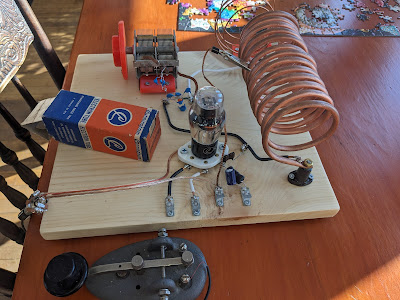'Sat in Sun' satpack feature?
My current iteration of the Satpack full doppler tuning device has about 30k of code space still available in the target hardware, a atmega 644p. Some of this will be eaten up with error checking around the tle loading and clock-setting, but there's still a fair bit of open space there.
PC-based tuning programs will often tell you if a bird is eclipsed or in the sun, a feature that is even more useful these days as the aging AO-51 is not transponding in eclipse. Similarly, the AMSAT-UK video entitled 'FUNcube part one' states at its end that FUNcube will have a high-power telemetry mode while in sun (roughly when school is in session), and a low-power telemetry + transponder mode when it is in eclipse (roughly when school is out). This scheme fits the FUNcube KISS principle, but won't be ideal for the small but important number of students who live in Arctic regions.
So a 'sat in sun' indicator on the LCD is going to be more important than ever, but I wonder if we can go further and include insolation in our tracking logic. A HT user in the field really doesn't want his HT to start automatically tuning AO-51 if it isn't in the sun, so we might as well exclude AO-51 if it is in eclipse. Same thing with AO-7. FUNcube is a bit harder case, since they plan to be more clever with the schedule, keeping the transponder on all the time during weekends and school holidays.
Finally, there's the schedule of AO-27. I'd love to include some 'FM transponder on' code inside satpack so that it also only was tuned in when it is in transponder mode. Right now, it hogs the tuner pointlessly far too many times.
PC-based tuning programs will often tell you if a bird is eclipsed or in the sun, a feature that is even more useful these days as the aging AO-51 is not transponding in eclipse. Similarly, the AMSAT-UK video entitled 'FUNcube part one' states at its end that FUNcube will have a high-power telemetry mode while in sun (roughly when school is in session), and a low-power telemetry + transponder mode when it is in eclipse (roughly when school is out). This scheme fits the FUNcube KISS principle, but won't be ideal for the small but important number of students who live in Arctic regions.
So a 'sat in sun' indicator on the LCD is going to be more important than ever, but I wonder if we can go further and include insolation in our tracking logic. A HT user in the field really doesn't want his HT to start automatically tuning AO-51 if it isn't in the sun, so we might as well exclude AO-51 if it is in eclipse. Same thing with AO-7. FUNcube is a bit harder case, since they plan to be more clever with the schedule, keeping the transponder on all the time during weekends and school holidays.
Finally, there's the schedule of AO-27. I'd love to include some 'FM transponder on' code inside satpack so that it also only was tuned in when it is in transponder mode. Right now, it hogs the tuner pointlessly far too many times.


I hope I'm not to late with this project but I've been thinking about building my own az/el rotator for sat operation and stumbled over your project. I'll be working on the rotator hardware first then it'll be the control side. I was wondering if your project is something that s compatible, it looks very highly developed and very interesting
ReplyDeleteAlex, http://g7kse.co.uk